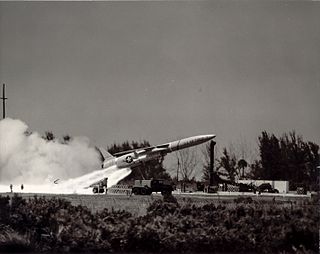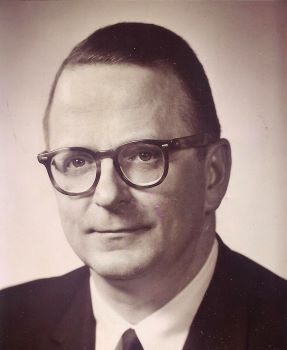
An analog computer or analogue computer is a type of computer that uses the continuous variation aspect of physical phenomena such as electrical, mechanical, or hydraulic quantities to model the problem being solved. In contrast, digital computers represent varying quantities symbolically and by discrete values of both time and amplitude.

The history of computing hardware covers the developments from early simple devices to aid calculation to modern day computers.

John Adam Presper Eckert Jr. was an American electrical engineer and computer pioneer. With John Mauchly, he designed the first general-purpose electronic digital computer (ENIAC), presented the first course in computing topics, founded the Eckert–Mauchly Computer Corporation, and designed the first commercial computer in the U.S., the UNIVAC, which incorporated Eckert's invention of the mercury delay-line memory.
BINAC was an early electronic computer designed for Northrop Aircraft Company by the Eckert–Mauchly Computer Corporation (EMCC) in 1949. Eckert and Mauchly, though they had started the design of EDVAC at the University of Pennsylvania, chose to leave and start EMCC, the first computer company. BINAC was their first product, the first stored-program computer in the United States; BINAC is also sometimes claimed to be the world's first commercial digital computer even though it was limited in scope and never fully functional after delivery.

The Z3 was a German electromechanical computer designed by Konrad Zuse in 1938, and completed in 1941. It was the world's first working programmable, fully automatic digital computer. The Z3 was built with 2,600 relays, implementing a 22-bit word length that operated at a clock frequency of about 5–10 Hz. Program code was stored on punched film. Initial values were entered manually.

The Northrop SM-62 Snark is an early-model intercontinental range ground-launched cruise missile that could carry a W39 thermonuclear warhead. The Snark was deployed by the United States Air Force's Strategic Air Command from 1958 through 1961. It represented an important step in weapons technology during the Cold War. The Snark was named by Jack Northrop and took its name from the author Lewis Carroll's character the "snark". The Snark was the only surface-to-surface cruise missile with such a long range that was ever deployed by the U.S. Air Force. Following the deployment of ICBMs, the Snark was rendered obsolete, and it was removed from deployment in 1961.

The differential analyser is a mechanical analogue computer designed to solve differential equations by integration, using wheel-and-disc mechanisms to perform the integration. It was one of the first advanced computing devices to be used operationally. The original machines could not add, but then it was noticed that if the two wheels of a rear differential are turned, the drive shaft will compute the average of the left and right wheels. Addition and subtraction are then achieved by using a simple gear ratio of 1:2; the gear ratio provides multiplication by two, and multiplying the average of two values by two gives their sum. Multiplication is just a special case of integration, namely integrating a constant function.

The Bendix G-15 is a computer introduced in 1956 by the Bendix Corporation, Computer Division, Los Angeles, California. It is about 5 by 3 by 3 feet and weighs about 966 pounds (438 kg). The G-15 has a drum memory of 2,160 29-bit words, along with 20 words used for special purposes and rapid-access storage. The base system, without peripherals, cost $49,500. A working model cost around $60,000. It could also be rented for $1,485 per month. It was meant for scientific and industrial markets. The series was gradually discontinued when Control Data Corporation took over the Bendix computer division in 1963.
Max Palevsky was an American art collector, venture capitalist, philanthropist, and computer technology pioneer. He was known as a member of the Malibu Mafia – a group of wealthy American Jewish men who donated money to liberal and progressive causes and politicians.

A computer is a machine that can be programmed to carry out sequences of arithmetic or logical operations (computation) automatically. Modern digital electronic computers can perform generic sets of operations known as programs. These programs enable computers to perform a wide range of tasks. A computer system is a nominally complete computer that includes the hardware, operating system, and peripheral equipment needed and used for full operation. This term may also refer to a group of computers that are linked and function together, such as a computer network or computer cluster.
A digital differential analyzer (DDA), also sometimes called a digital integrating computer, is a digital implementation of a differential analyzer. The integrators in a DDA are implemented as accumulators, with the numeric result converted back to a pulse rate by the overflow of the accumulator.
The Oslo Analyzer was a mechanical analog differential analyzer, a type of computer, built in Norway from 1938 to 1942. It was the largest computer of its kind in the world when completed.
Helmut Hoelzer was a Nazi Germany V-2 rocket engineer who was brought to the United States under Operation Paperclip. Hoelzer was the inventor and constructor of the world's first electronic analog computer.
The general purpose analog computer (GPAC) is a mathematical model of analog computers first introduced in 1941 by Claude Shannon. This model consists of circuits where several basic units are interconnected in order to compute some function. The GPAC can be implemented in practice through the use of mechanical devices or analog electronics. Although analog computers have fallen almost into oblivion due to emergence of the digital computer, the GPAC has recently been studied as a way to provide evidence for the physical Church–Turing thesis. This is because the GPAC is also known to model a large class of dynamical systems defined with ordinary differential equations, which appear frequently in the context of physics. In particular it was shown in 2007 that the GPAC is equivalent, in computability terms, to Turing machines, thereby proving the physical Church–Turing thesis for the class of systems modelled by the GPAC. This was recently strengthened to polynomial time equivalence.
The Computer Research Corporation (CRC) was an early developer of minicomputers. It was founded on July 16, 1950.

Floyd George Steele was an American physicist, engineer, and computer designer who grew up in Boulder, Colorado. He is known for leading the design team at Northrup that developed the MADIDDA, an early digital computer.

The Model V was among the early electromechanical general purpose computers, designed by George Stibitz and built by Bell Telephone Laboratories, operational in 1946.
The PB 250 was a general-purpose computer introduced in 1960 by the Packard Bell Corporation.

Perry Orson Crawford, Jr. was an American computer pioneer credited as being the first to fully realize and promote the value of digital, as opposed to analog, computers for real-time applications. This was in 1945 while advising Jay Forrester in developing flight simulators and anti-aircraft fire control devices during World War II, before practical digital computers had been produced. His similar foresight on related issues led to his heading twelve years later the design team for IBM's SABRE project, the ticketing system for American Airlines, the first large-scale commercial application of real-time computer systems, which became the model for on-line transaction processing.
Samuel Lubkin (1906-1972) was a mathematician and computer scientist instrumental in the early history of computing.












